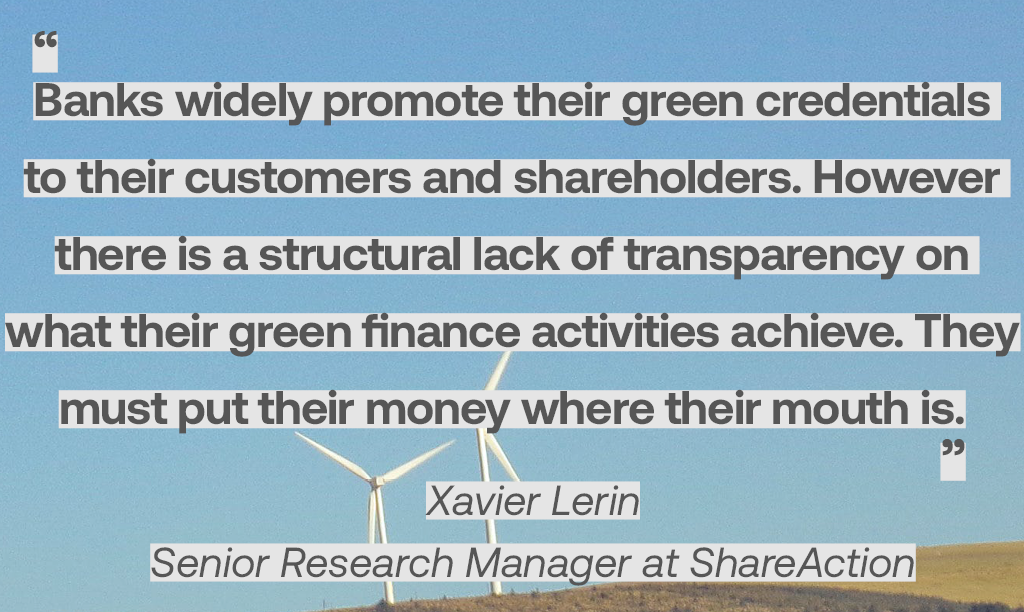In a new ShareAction investigation published today, we examine whether the top 20 European banks report transparently on their green finance ambitions - or if claims of greenwashing against them are true. Worryingly, we found that their hazy target-setting and reporting makes it unclear whether they really are committed to a green energy future that we all need to mitigate the consequences of climate change.
Greenwashing: The creation or propagation of an unfounded or misleading environmentalist image (Oxford English Dictionary)
Green finance: the flow of money from the public, private sector, or non-profit sector, that funds sustainable developments that tackle climate change, rebuild natural ecosystems and support jobs in green sectors (Gov.uk)
The banks that the majority of us trust with our cash are simultaneously putting a lot of money towards climate breakdown, threatening the future of our planet. They’re heavily investing in industries such as gas, oil, and coal, and they do this for one reason only - to generate obscene profits.
Many banks stick a tiny, green-coloured plaster over the issue, assuring the public that they’re also dedicating money to environmental solutions – through vital projects such as renewable energy and clean transportation - but just how true are these claims? Here at ShareAction we pride ourselves on industry-leading research that sheds light on financial institutions that harm the planet and its people – so we wanted to find out.

In new research published today, we investigated how the 20 largest listed European banks (including Barclays, HSBC, and NatWest) set their green finance targets and how they report on their progress. What we found shows that their green targets and disclosures are not fit for purpose and could lead to misleading claims – aka greenwashing. These banks are trying to make themselves look better and greener than they actually are.
A good example of this comes from Barclays – a bank who is ‘dedicated to helping companies take action to address the environmental and sustainability challenges facing our planet’. They claim to be ‘providing the green and sustainable finance required to transform the economies it serves’.
Sounds great, but - Barclays is Europe’s biggest funder of fossil fuels.
You can see why people are confused. Let’s have a look at some of the findings from our new research…
All 20 banks are using different targets and ways of disclosing information, and the targets they do set are often unclear
This means they all could be talking about something different when it comes to their sustainability claims. A running theme throughout our findings is that this shows a real lack of transparency, with banks able to set their own targets and deciding what they do and don’t report on.
They’re also mixing the actual funding of these green projects with other products and services – and bundling various sustainability themes together without outlining sub-targets. This makes it overall very difficult to see how banks are expecting to align their financing activities with the goal to limit global warming to 1.5C.
Only three out of the 20 banks we looked into actually published information on how they calculated their targets, and only 7 do any sort of reporting on the impact of their ‘green financing'
Again with the lack of transparency and ambition – in a time when we must be more so than ever. For example, very few banks would illustrate how many gigawatts of renewable energy their green finance leads to - sending into question the impact of their green funding on the much-needed energy transition.
Current green finance targets may not lead to enough funding for less well-developed solutions, or for the Global South
The Global South is ‘unequivocally more vulnerable to climate change than the Global North, owing to widespread poverty, income inequality and its heavy dependence on climate-sensitive sectors’, and is actually home to the majority of the global population. Banks must be prioritising green finance where it’s needed the most.
Banks are not always disclosing what activities they class as ‘green’
…and some of those that do are counting controversial, carbon-intensive power generating activities such as natural gas or biomass as ‘green’.
Banks are using double standards
Banks are using different quantifications when setting targets for their green financing vs setting targets for their carbon-related activities. Unsurprisingly, this has led to them underestimating the negative impacts of their carbon emissions, whilst overestimating the positive impacts of their green financing.
We also recognise that banks face obstacles and challenges when it comes both providing and reporting on green finance – making it harder for them to do so. However, in the face of the climate emergency, they must be doing more.
For the full breakdown of findings and ShareAction’s recommendations, you can read our new report here.
You might also be interested in:
Add your name to tell Barclays ‘No money for new oil and gas’ here.
Donate to support our work here.